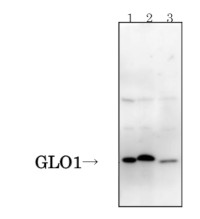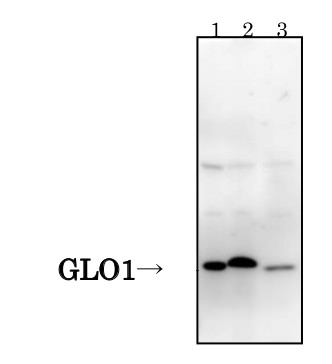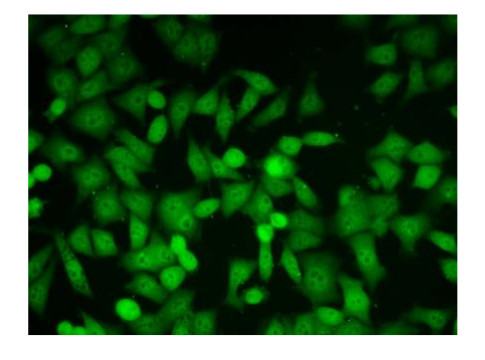1

Anti-GLO1 | Glyoxalase I (clone 6F10)
AS21 4568 | Clonality: Monoclonal | Host: Rat | Reactivity: human, simian, mouse
- Product Info
-
Sub class: IgG2b kappa Immunogen: Recombinant, full-length mouse GLO1 UniProt: Q9CPU0 fused to GST Host: Rat Clonality: Monoclonal
Purity: Proprietary affinity chromatography in PBS. Contains 50% glycerol, filter sterilized. Format: Liquid Quantity: 100 µg Storage: Store at -20°C; make aliquots to avoid repeated freeze-thaw cycles. Please remember to spin the tubes briefly prior to opening them to avoid any losses that might occur from material adhering to the cap or sides of the tube. Tested applications: ELISA (ELISA), Immunofluorescence (IF), Western blot (WB) Recommended dilution: 1 : 1000 (WB) Expected | apparent MW: 27 kDa (mouse, 29 kDa (human, simian) - Reactivity
-
Confirmed reactivity: Human, simian, mouse Predicted reactivity: Species of your interest not listed? Contact us - Application Examples
-

Whole cell extracts of simian COS-1 (1), mouse L929 (2), human HeLa (3) were separated on SDS-PAGE and blotted to a PVDF membrane, followed by blocking in 5 % non-fat milk for 1h/RT. The primary antibody was incubated at 1: 1000 for 1 h/RT, followed by washes and incubation with a secondary anti-rat IgG HRP conjugated antibodies, used at 1: 10 000 1h/RT. The reaction was developed using chemiluminescence following manufacture's recommendations.
Immunofluorescent staining of HeLa cells with anti-GLO1 antibodies. Cells were fixed with 4 % paraformaldehyde, permabilized with 0.2 % Triton X-100. The primary antibodies were used at 1: 500 and the secondary antibodies, goat anti-rat IgG, FITC conjugated were used at 1: 5000. - Background
-
Background: Glyoxalase I (GLO1) is an enzyme that plays a role in the detoxification of methylglyoxal (MG), a side-product of glycolysis, via condensation with glutathione to produce S-lactoyl-glutathione. GLO1 is a zinc metalloenzyme whose crystal structure has been solved. The bacterial and yeast enzymes are monomeric while the mammalian one is homodimeric and its sequence is well conserved. GLO1 is found over-expressed in some tumors. GLO1 has also been suggested to be involved in anxiety diseases, autism, and Alzheimer’s disease. - Product Citations
-
Selected references: Jiang et al. (2018). Role of the Glyoxalase System in Alzheimer's Disease. J Alzheimers Dis. 2018;66(3):887-899. doi: 10.3233/JAD-180413. PMID: 30400091.
Hovatta et al. (2005) Glyoxalase 1 and glutathione reductase 1 regulate anxiety in mice. Nature. 2005 Dec 1;438(7068):662-6. doi: 10.1038/nature04250. Epub 2005 Oct 23. PMID: 16244648.
Junaid et al. (2004) Proteomic studies identified a single nucleotide polymorphism in glyoxalase I as autism susceptibility factor. Am J Med Genet A. 2004 Nov 15;131(1):11-7. doi: 10.1002/ajmg.a.30349. PMID: 15386471; PMCID: PMC1360505. - Protocols
- Antibody protocols
- Reviews:
-
This product doesn't have any reviews.


